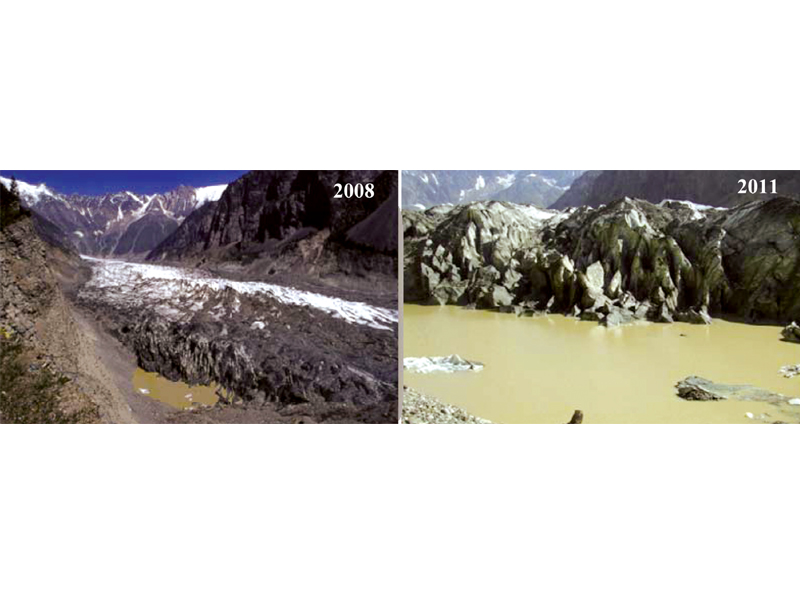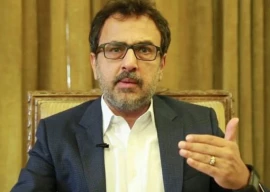
Two early warning systems are expected to help vulnerable communities in northern areas reduce the risk of flooding from glacial lakes this summer. These are: increase in weather monitoring stations and awareness-raising activities.
These steps are part of the ongoing Pakistan Glacial Lake Outburst Flood (GLOF) project being implemented by the Ministry of Climate Change with technical support from the Pakistan Meteorological Department (PMD).
A GLOF occurs when the dam of a glacial lake bursts, releasing water downstream at a soaring speed and risks the lives of communities that could find themselves in the flood’s path. The frequency of GLOFs in Pakistan has increased during the past few years, according to scientists and glaciologists.
In 2008, a lake at the Gulkin Glacier in Upper Hunza burst three times in two months, flooding the nearby village and destroying around 50 houses. The Korambar Glacier near Iskhoman Valley and the Buni Gole Glacier near Chitral generated GLOFs in 2010 and 2012, causing damages to agricultural land and settlements on each occasion.

Pakistan has 2,420 glacier lakes — lakes that are fed by water from glacial melt — and 52 of these lakes are “potentially hazardous” and likely to cause GLOFs in the future, according to a 2005 International Centre for Integrated Mountain Development (ICIMOD) report.
“GLOFs have the potential to release millions of cubic meters of water and debris, with peak flows as high as 15,000 cubic metres per second,” according to a UNDP report.
At these speeds, GLOFs can simply wipe out villages and towns in the valleys situated below, said GLOF Project Manager Khalil Ahmed.
“You are lucky if you can get out of its way in time, otherwise you are gone,” Ahmed said.
The spike in flood cases and their destructive potential increases the significance of the $7.6 million GLOF project — Pakistan’s first government-level climate change adaptation initiative.

Ahmed said the project is trying to develop the technical capacity of government institutions to understand GLOF risks as well as creating awareness among vulnerable communities in GLOF-prone areas to increase their response time. The project, which will run until 2015, is focused on 2,845 households in the GLOF-prone Bindo Gol and Bagrot valleys of Chitral and Gilgit respectively.
Adaptive measures
On the technical side, the project teamed up with PMD to set up automatic weather stations that could collect hitherto unavailable data on the glaciers.
Ghulam Rasool, chief meteorologist at PMD, said they had set up four stations on the Baltoro and Passu glaciers to record temperature, humidity and precipitation as well as monitor levels of glaciers, glacial lakes and run-off water.
Equipment for 14 weather stations was bought during the project’s first year.
From next month, Rasool said, the PMD will start setting up four more stations on the same glaciers. In addition, two early warning systems will be piloted at one site in Chitral Valley and another in Gilgit. “We have the option of using a siren system or a flashing light signal to alert communities for evacuation in the case a GLOF incident is expected,” Rasool said.
Engineering structures that could divert the flood water away from communities will be built at five sites each in Chitral and Gilgit valleys, Ahmed said. The PMD has also been tasked to do an on-ground inventory for potentially hazardous glacial lakes to validate the ICIMOD report which was based on satellite data. PMD verified around seven lakes in the past season and aims to verify at least 10 more this year, stated Ahmed.
Building resilience
But the most important part of the project is the participation of local communities living in GLOF-prone areas, he said. “The communities at risk are being trained to conduct evacuation procedures themselves,” he added. “Earlier, the locals dubbed GLOFs God’s wrath and they never thought about tackling the issue,” Ahmed said, adding that “we cannot really stop GLOFs but we are teaching the communities to understand the phenomenon so they can build resilience to its risks.”
The locals have formed hazard watch groups at the village level and disaster risk management committees at the valley-level, Ahmed said. A disaster risk reduction fund, worth Rs1 million, has been constituted for the each valley-level committee, with the project’s support.
Ahmed said the only glitch in the project at present is that a project director, appointed by the government, has to approve funds and during the past one and a half years, four project directors have been transferred and posted which has caused delays and hampered implementation activities.
Published in The Express Tribune, May 27th, 2013.

















COMMENTS
Comments are moderated and generally will be posted if they are on-topic and not abusive.
For more information, please see our Comments FAQ